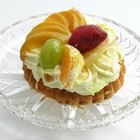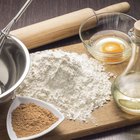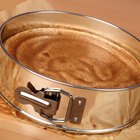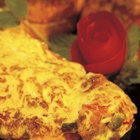
A perfectly baked cheesecake is silky on the inside and sports a flawlessly smooth finish on top. Even if you have a small crack or two, you can easily cover it with ganache or a whipped topping, but when a cheesecake sinks in the center, it means something went wrong during the process -- temperature, improper mixing or timing issues all can cause a cheesecake to sink after it’s baked and cooled. A lot of these issues can be corrected so you have a perfect cheesecake.
Mix, Don’t Whip
Cheesecakes are airy and smooth, but they don’t need to be whipped to reach that point. Over-whipping your cheesecake batter can add excess air and as the cheesecake bakes that air inflates the cake and quickly deflates once it cools. You can beat the cream cheese until soft and smooth, then mix in the other ingredients using a spoon or paddle attachment, but never a whisk attachment on a mixer. Continue to mix using a low to medium speed until the batter takes on a satiny finish -- about one to two minutes after everything is incorporated.
Temperature Matters
Cold cheesecake ingredients require longer mixing and longer mixing adds too much air to the batter -- leaving you with a sunken center. Bring all of your ingredients to room temperature, including the eggs and cream cheese. By taking the ingredients out about 30 minutes before you’re ready to use them you can bring them to room temperature. If you don’t have time, soften the cream cheese in the microwave, unwrapped on high for 30 to 45 seconds until softened. Don’t use melted or warm cream cheese -- this can curdle.
Add More Structure
Because cheesecakes are custards, your cheesecake might be too soft to hold itself up. You can add in more structure by incorporating 1 to 2 tablespoons of flour or cornstarch into the batter. Your cheesecake might have a firmer texture, but its structure will be more stable. If you want your cheesecake to be creamy, just add flour and not cornstarch.
Pay Attention to the Eggs
As with any custard, including cheesecake, it is all about the eggs. Cheesecakes rely on eggs to lift them up as they bake and give you a rich, thick and creamy final product. Use a medium speed when you add the eggs and add them one at a time -- beating at a slow speed and frequently scraping down the sides of the bowl. Avoid beating too much air into your eggs, because this can cause your cheesecake to fall. Use a low heat -- about 160 degrees Fahrenheit -- so the eggs coagulate and provide structure to your cheesecake, keeping it upright.
Related Articles

Does Adding an Extra Egg to Brownie Mix ...
Easy Vanilla Cupcake Recipe

Will My Dumplings Get More Airy As They ...

Can You Whip Egg Whites Without an ...

Problems With Whipping Egg Whites

How to Make Almond Buttercream Frosting

Do Eggs Make Baked Goods Rise?

How to Stop Cakes From Dropping
What Do Bakeries Use in Their Whipped ...

How to Make Peanut Butter Easter Eggs

Brownie Bottom Butterscotch Cheesecake ...

How to Make a Tall Fluffy Cheesecake

Will Gummy Worms Melt If Baked in ...

How to Make New York Cheesecake

How to Make Omelets With Baking Powder
How to Make Bakery-Style Whipped Icing
What Causes My Cake to Fall When ...

How to Make Hard Pretzels

How to Fix Grainy Whipped Ganache

How to Melt Marshmallows for Icing
References
Writer Bio
Shailynn Krow began writing professionally in 2002. She has contributed articles on food, weddings, travel, human resources/management and parenting to numerous online and offline publications. Krow holds a Bachelor of Science in psychology from the University of California, Los Angeles and an Associate of Science in pastry arts from the International Culinary Institute of America.
Photo Credits
Hemera Technologies/PhotoObjects.net/Getty Images